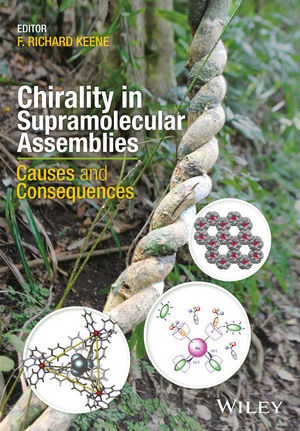Ulteriori informazioni
Informationen zum Autor Emeritus Professor F. Richard Keene Adjunct Professor of Chemistry, School of Pharmacy & Molecular Sciences, James Cook University, Australia and Department of Chemistry, University of Canterbury, New Zealand. Honorary Visiting Research Fellow, School of Chemistry & Physics, University of Adelaide Richard Keene is an acknowledged international authority on stereochemistry in coordination chemistry - and significantly, in the control of stereochemistry within polymetallic supramolecular assemblies - and has over the last decade has published widely on (i) its effect on intramolecular electron and energy transfer in such assemblies, and (ii) its influence on sequence- and structure-selectivity in the interaction of such complexes with nucleic acids, and their cytotoxicity to cancer cells and bacteria. He has over 160 publications (h-index 44), as well 6 chapters in monographs and a patent. Klappentext Supramolecular chemistry deals with the organisation of molecules into defined assemblies using non-covalent interactions, including weaker and reversible interactions such as hydrogen bonds, and metal-ligand interactions. The aspect of stereochemistry within such chemical architectures, and in particular chirality, is of special interest as it impacts on considerations of molecular recognition, the development of functional materials, the vexed question of homochirality, nanoscale effects of interactions at interfaces, biocatalysis and enzymatic catalysis, and applications in organic synthesis.Chirality in Supramolecular Assemblies addresses many of these aspects, presenting a broad overview of this important and rapidly developing interdisciplinary field. Topics covered include:* Origins of molecular and topological chirality* Homochirogenesis* Chirality in crystallinity* Host-guest behavior* Chiral influences in functional materials* Chirality in network solids and coordination solids* Aspects of chirality at interfaces* Chirality in organic assemblies* Chirality related to biocatalysis and enzymes in organic synthesis.This book is a valuable reference for researchers in the molecular sciences, materials science and biological science working with chiral supramolecular systems. It provides summaries and special insights by acknowledged international experts in the various fields. Zusammenfassung Supramolecular chemistry deals with the organisation of molecules into defined assemblies using non-covalent interactions, including weaker and reversible interactions such as hydrogen bonds, and metal-ligand interactions. Inhaltsverzeichnis List of Contributors xi Preface xiii 1 Principles of Molecular Chirality 1 Jean?]Claude Chambron and F. Richard Keene 1.1 General Introduction 1 1.2 Geometrical Chirality 2 1.3 Topological Chirality 25 1.4 Conclusion 39 References 39 2 Homochirogenesis and the Emergence of Lifelike Structures 44 Pedro Cintas 2.1 Introduction and Scope 44 2.2 The Racemic State: Mirror Symmetry Breaking 45 2.3 Asymmetric Oligomerization 49 2.4 Biochirality in Active Sites 58 2.5 Conclusions 61 Acknowledgements 61 References 61 3 Aspects of Crystallization and Chirality 65 Roger Bishop 3.1 Introduction 65 3.2 Crystal Space Groups 65 3.3 Fundamentals of Crystallization for a Racemic Mixture 69 3.4 More Complex Crystallization Behavior 71 3.5 Multiple Crystal Forms 74 3.6 Conglomerates Revisited 85 References 90 4 Complexity of Supramolecular Assemblies 94 Jonathan A. Kitchen and Philip A. Gale 4.1 Introduction 94 4.2 Generating Supramolecular Chirality through Assembly of Achiral Components 96 4.3 Enantioselective Supramolecular Assemblies 121 4.4 Conclusions and F...

